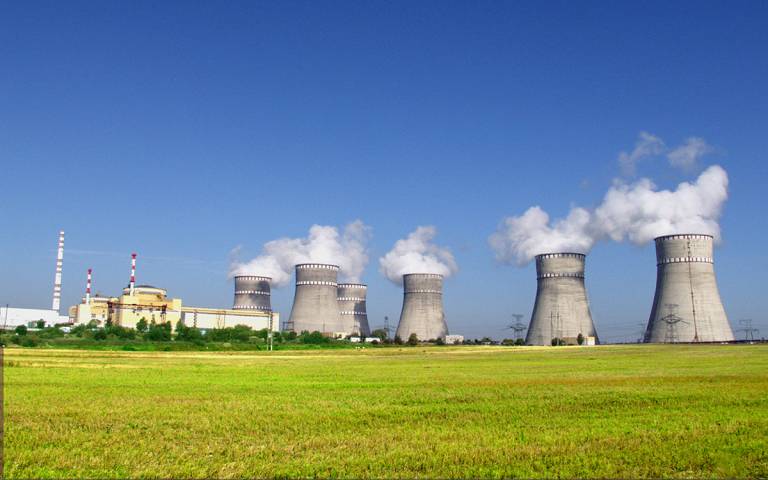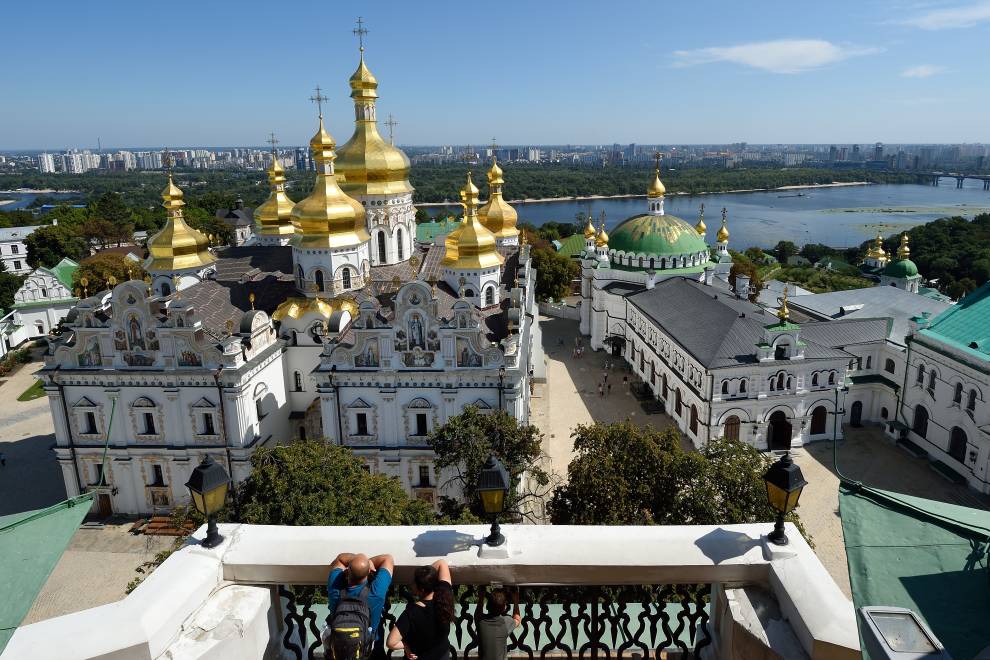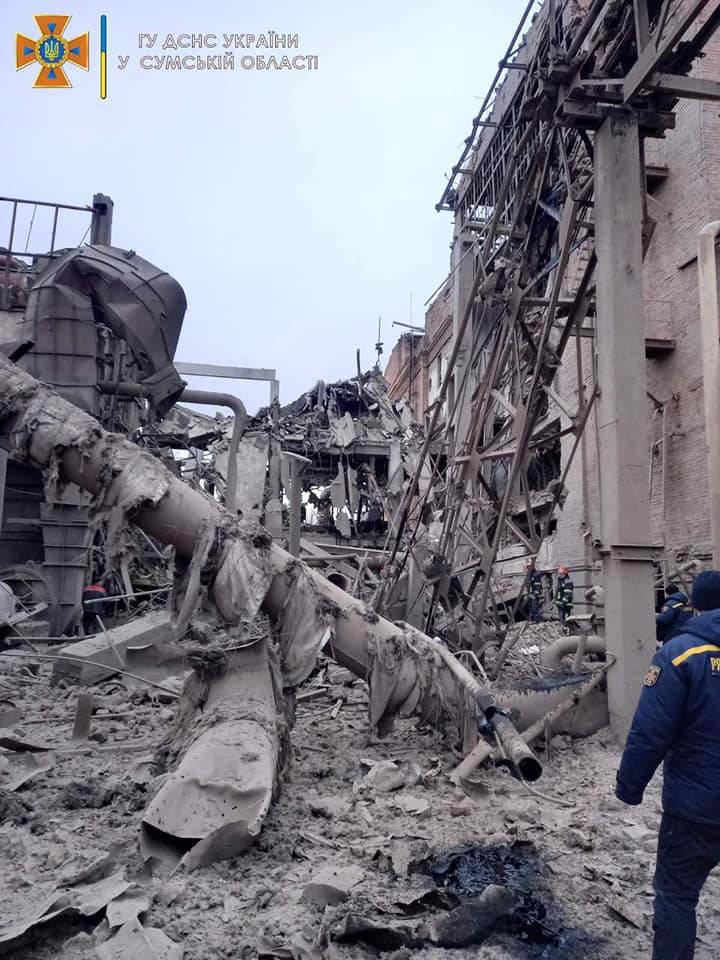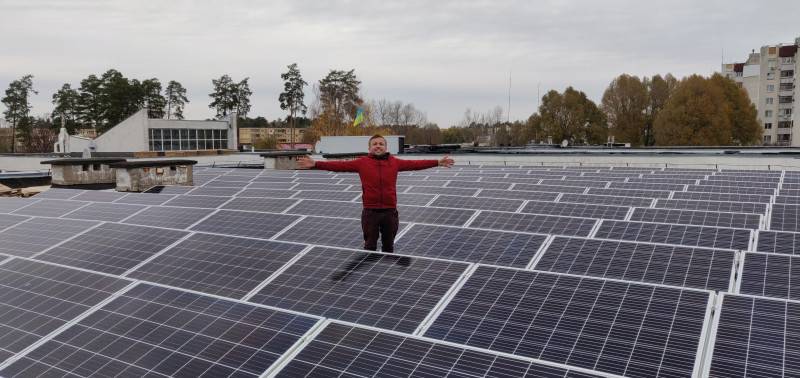Blue, gold and green: Sustainable energy in Ukraine
23 May 2023
Crises arising from Russia’s invasion of Ukraine have severely damaged the country's energy infrastructure. As well as short term shortages, longer-term recovery will pose considerable challenges. Sustainable energy could play a key role in both timescales.

By Nick Hughes, Bartlett Faculty Lead for Climate Action, and Yaroslav Melekh, Research Fellow in Economics of Energy Innovation and Systems Transition
Content warning: images of shell/bomb damage
Across the Bartlett Faculty, we are continuing to think about how the academic travel we do can be reconciled with our net-zero target, with numerous discussions on this question taking place within the Faculty’s departments and institutes. These deliberations will culminate in a cross-faculty discussion event on Wednesday 28 June 2023. All Bartlett staff and students are welcome to join this discussion. Registration will be open until Thursday 15 June – but places are limited, so don’t delay!
Throughout the discussions we have been having on this issue, a common theme has been the importance of addressing the environmental impact of the work we do, whilst still remaining an outward looking, globally oriented research community.
In this blog, my colleague from the Institute for Sustainable Resources, Yaroslav Melekh and I reflect on the current situation in Ukraine, from the perspective of sustainable energy, both in terms of near term urgent needs, and through more optimistic and longer term aspirations of a 'green recovery'.

The crisis arising from Russia’s invasion has taken a heavy toll on the people of Ukraine. A major impact of the war on civilians has been through its impact on energy infrastructure, including electricity, gas and heat supplies. According to the UNDP, “the average Ukrainian household had to endure five cumulative weeks without power during the winter of 2022.”
The same source finds that over the last year, the war has seen “22 out of 36 power generation plants damaged, destroyed or inaccessible, and a large part of the heating infrastructure in war-affected areas broken beyond repair.” Nearly 10 GW of electricity generation capacity may have been destroyed and lost since the start of the war, and 43% of high-voltage networks have been severely damaged, with crews of network engineers battling to repair the damage.
The destruction of electricity infrastructure has not only disrupted access to power itself, but also severely affected water and heat supply to the residential sector, and threatened the operation of hospitals and health facilities, further exacerbating the humanitarian crisis. Loss of energy also disrupts the activity of businesses, contributing to the severe economic losses the country has experienced.
Even so, in July 2022, within months of the start of the war, the Ukrainian government’s National Recovery Council launched Ukraine’s National Recovery Plan – a profoundly optimistic document, with objectives to “provide economic, social and environmental resilience in the marathon to victory”, and “not just to recover war-related damages, but to leapfrog economic growth and quality of living in Ukraine.” Amongst the numerous projects listed in the document, are ambitions to increase energy system integration with the EU, to play a role in the EU’s green energy transition, to diversify and decarbonise its own energy mix, and to invest in energy efficiency.

Damage sustained by a combined heat and power plant in Okhtyrka city, Sumy Oblast, Ukraine, after Russian airstrike on 3 March 2022. Credit: State Emergency Services of Ukraine (dsns.gov.ua) CCA 4.0
Realising such plans will require significant investment. A year after the invasion, the World Bank estimated the reconstruction and recovery investment needs for Ukraine to become a “modern, low-carbon, disaster- and climate-resilient country” at $411 billion, including $47 billion for the energy sector. But this long-term planning must also be aligned with the urgency of the ongoing war, and its extreme and immediate impacts, with planning to reduce the impacts of lost energy infrastructure on civilians in the next winter period, and to build the country’s resilience in a highly uncertain context.
Are there investment options which could meet both near-term and long-term concerns?
Historically, nearly 50% of Ukraine’s electricity mix has been supplied by state-owned nuclear energy, and Ukraine’s National Recovery Plan indicates intentions to expand the country’s nuclear fleet. However, further investments in large-scale nuclear power plants are extremely difficult in the current context, and such infrastructure is particularly exposed to risks in armed conflicts.
The challenges associated with large-scale and particularly nuclear generation plants are well illustrated in the current (May 2023) situation in Ukraine’s Zaporizhzhia plant, Europe’s largest nuclear power station with a capacity of 6 GW, which is currently within Russian-occupied territory, and a source of significant ongoing risk due to the conflict.
In contrast, it could be argued that a more dispersed and decentralised renewable energy system, using sources such as wind, solar and biomass, could offer the potential advantage of reducing overall dependence on a small number of large power plants connected with long-distance transmission networks. Thus, as well as potentially constituting the first steps on a green transition path, such decentralised investments might also offer crucial characteristics of resilience in the war-time context.
During the war, industrial energy users have shown increased interest in bidding for green energy, due to its greater resilience. In the longer term, green energy procurement could grant the same industrial users greater resilience to the EU Carbon Border Adjustment Mechanism (CBAM).
However, a significant challenge is how to get investment into green energy technologies given the current conditions.
Even before the war, institutional conditions in Ukraine were challenging. The political priority given to state-owned nuclear generation tended to crowd-out private funded investments in renewables, despite their cost-effectiveness. Poorly designed support schemes for renewables and cross-subsidies for electricity supply to the residential sector, sent the wrong signals to investors and hindered the green transition. However, well-designed regulations for bilateral power purchase agreements (PPAs), and the country’s natural abundance of renewable energy, could be the drivers for the private sector to continue developing new projects, as discussed during the Ukrainian Energy Transition Forum held in London in April, 2023.

Given the current extreme risks posed by the war, multilateral organisations and international financial institutions are working closely with other governments to develop war-time and post-war-time special guarantees and insurance, to enable investors to invest in Ukraine.
Going forward, Ukraine green reconstruction and recovery seeks to look beyond the above-mentioned renewables. In February, 2023 the EU and Ukraine signed a Memorandum of Understanding on a Strategic Partnership on biomethane, hydrogen and other synthetic fuels.
Given the country’s substantial agricultural sector and wood-processing industry, bioenergy has developed quite significantly, at an average rate of 31% per year since 2010. Biomass, used for district heating and in some combined heat and power (CHP) units, can contribute to energy security and affordability, reducing the demand for expensive and geopolitically exposed natural gas. Another relatively new area is biomethane. Despite the full-scale war, the country’s first-ever biomethane production plant was commissioned in April 2023.
Hydrogen is another potentially green energy carrier that is widely discussed in Ukraine. Although in very early days, Ukraine’s pre-full-scale invasion ambitions included an installation of 8 GW of electrolysis capacities with targeted production of 21 TWh of green hydrogen annually, primarily targeted at export to the EU. As in all countries, the currently still high price tag of hydrogen infrastructure remains a barrier. But, given that major blast-furnace-operated steel mills were destroyed during the war, an ambitious green reconstruction programme could see green hydrogen offering a route to low-carbon steel production.
Ukraine has a strong mining tradition; but as well as coal, it has “high potential” in critical raw material reserves of significance to the low carbon transition, according to another EU-Ukraine memorandum, which aims to “deepen cooperation in the field of raw materials and batteries”.
In the long term, then, there is a considerable potential for Ukraine to follow a prosperous, Europe-facing, green recovery path. However, the first steps along that path are likely to be taken in a context of persistent disruption and uncertainty, and hence must be resilient to that context. Heavily bombed thermal power plants and occupied nuclear power plants may encourage Ukraine to pursue resilience as well as decarbonisation, by rebuilding a more distributed, decentralised and renewable energy system.
Lead image: Rivne Nuclear Power Plant, credit: Dyakov Vladimir Leonidovich, CCA 3.0
 Close
Close

